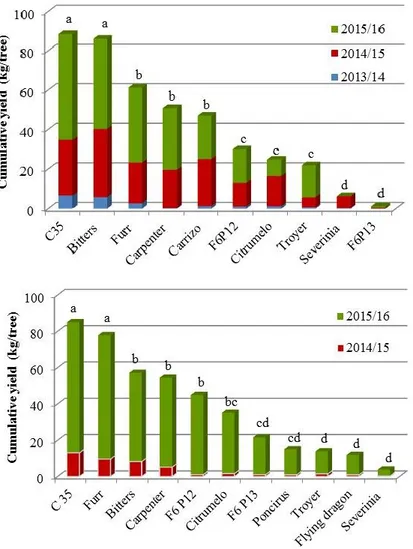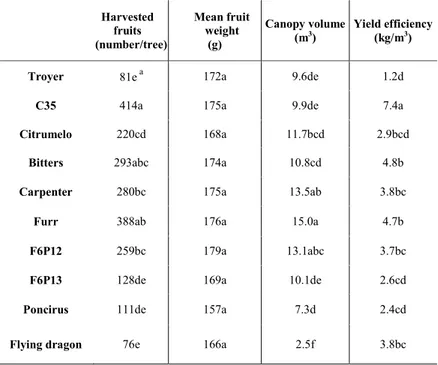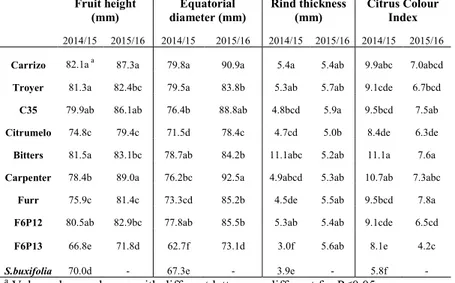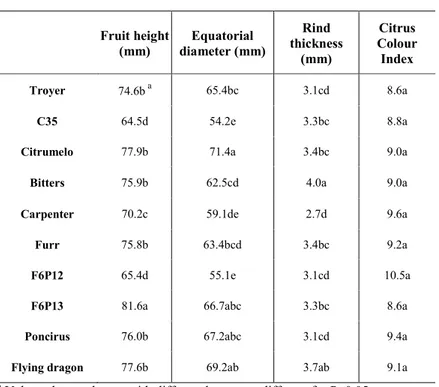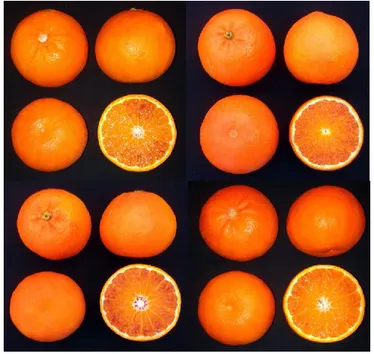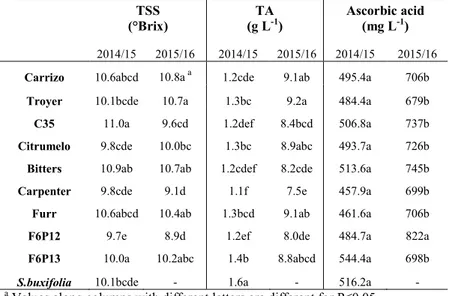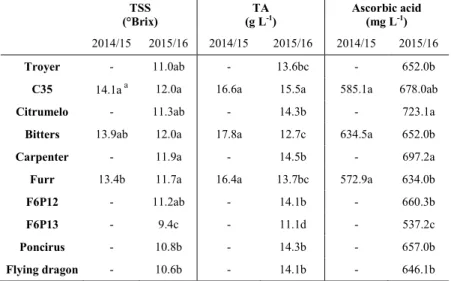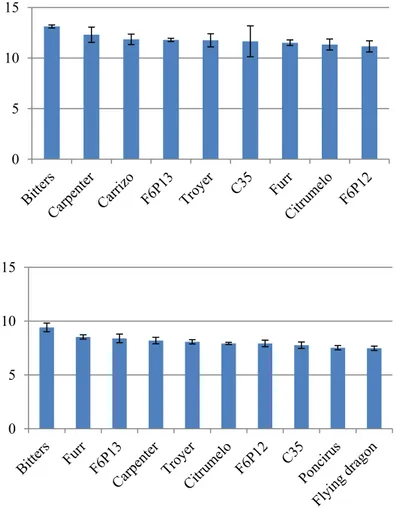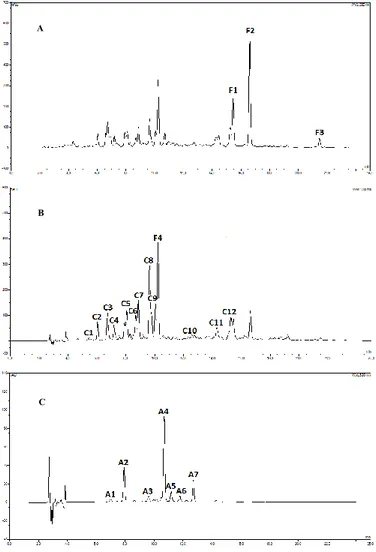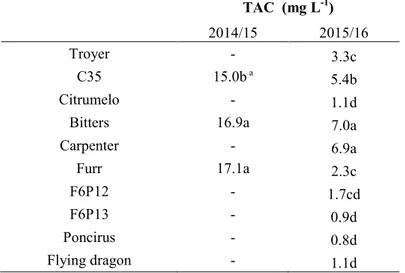U
NIVERSITÀ DEGLI
S
TUDI DI
C
ATANIA
AGRICULTURAL, FOOD AND ENVIRONMENTAL SCIENCE
XXIX CICLE
Study of agronomical and postharvest factors influencing qualitative and nutraceutical traits
on blood orange and pomegranate fruits
Claudia Rita Pannitteri
Advisor: Alberto Continella Co-advisor: Stefano La Malfa Coordinator: Cherubino Leonardi Ph. D. attended during 2013-2016
Contents
ABSTRACT ... 1
SOMMARIO ... 3
List of abbreviations ... 5
INTRODUCTION ... 6
Quality concept in horticulture ... 6
1.Definition ... 7
2.The quality for fresh and processed fruits ... 7
3.Main quality parameters and methodologies for their assessment ... 9
3.1 Size ... 9
3.2 Colour ... 10
3.3 Texture... 13
3.4 Taste ... 15
4.Bioactive compounds and nutraceutical aspects ... 17
4.1 Reactive oxygen species (ROS) ... 18
4.2 Alkaloids ... 20 4.3 Glucosinolates ... 20 4.4 Terpenes ... 20 4.5 Phenolic compounds ... 21 4.5.1 Flavonoids group ... 23 4.5.2 Non-flavonoids group... 26 4.6 Vitamins ... 28
4.6.1 Fat-soluble vitamins ... 28
4.6.2 Water-soluble vitamins... 29
Sweet orange (Citrus sinensis L.) ... 29
1.Taxonomy and origin... 29
2.Economic importance and world diffusion ... 33
3.Morphological and physiological aspects... 34
4.Factors affecting fruit quality ... 39
4.1 Cultivar ... 39
5.Rootstock ... 43
6.Agricultural techniques ... 47
Pomegranate (Punica granatum L.) ... 49
1.Taxonomy and origin... 49
2. Economic importance and world diffusion ... 51
3. Morphological and physiological aspects... 52
4. Factors affecting fruit quality ... 54
4.1 Cultivar ... 54
5.Agronomic techniques ... 59
Aim of the PhD thesis ... 62
EXPERIMENTAL STUDIES ... 64
Experimental study # 1 ... 65
Influence of several rootstocks on yield precocity and fruit quality of two pigmented citrus cultivar ... 65
2.Materials and methods ... 67
2.1 Plant material ... 67
2.2 Field and fruit quality measurements ... 68
2.3 Morphological and physicochemical parameters determination ... 69
2.4 HPLC/DAD and HPLC/ESI/MS analyses ... 70
2.5 Antioxidant activity (ORAC, ABTS+ and DPPH• methods) and total polyphenols ... 73
2.6 Statistical analysis ... 74
3. Results and discussion ... 75
3.1 Field, morphological and physicochemical measurements ... 75
3.2 Identification of the main chemical compounds of Tarocco Scirè orange juice ... 87
3.3 Antioxidant activity (ORAC, ABTS+ and DPPH• methods) and total polyphenols ... 93
4. Conclusions ... 96
Experimental study # 2 ... 98
Influence of postharvest treatments on qualitative and chemical parameters of Tarocco blood orange fruits to be used for fresh chilled juice ... 98
1. Introduction ... 98
2. Materials and methods ... 100
2.2 Treatment and storage conditions ... 101
2.3 Morphological and physicochemical parameters determination ... 101
2.4 HPLC/DAD and HPLC/ESI/MS analyses ... 102
2.5 GC/MS analyses ... 102
2.6 Statistical analysis ... 103
3. Results and discussion ... 103
3.1 Effects of treatments on decay, morphological and physicochemical parameters during shelf life test ... 103
3.2 Identification of the chemical markers in Tarocco orange juice ... 107
3.3 Effects of treatments on chemical markers during shelf life test ... 112
3.4 Aroma evaluation during shelf life test ... 115
4. Conclusions ... 115
Experimental study # 3 ... 118
Nutraceutical and physicochemical characteristics of pomegranate fruits (Punica granatum L.) in two Mediterranean areas and their evolution during maturation stage. ... 118
1.Introduction ... 118
2.Morphological and physicochemical analysis ... 120
2.1 Fruit weight, size and colour measurements ... 121
2.2 Antioxidant activity (ABTS+, DPPH• and FRAP
methods) and total polyphenols ... 122
2.3 Mineral analysis ... 123
2.4 Statistical analysis ... 123
3.Results and discussion ... 124
3.1 Morphological and physicochemical analyses ... 124
3.2 Individual organic acids and sugar ... 125
3.3 Antioxidant activity (ABTS+, DPPH• and FRAP methods) and total polyphenols ... 126
3.4 Mineral analysis ... 127
4. Conclusions ... 135
Experimental study # 4 ... 137
Anthocyanin characterization and antioxidant capacity of some Sicilian pomegranate (Punica granatum L.) accessions in comparison with international varieties ... 137
1. Introduction ... 137
2. Material and methods ... 138
2.1 Plant material ... 138
2.2 Quality parameters determination ... 138
2.3 HPLC/DAD and HPLC/ESI/MS anthocyanin analysis ... 139
2.4 Statistical analysis ... 139
3. Results and discussion ... 139
3.2. HPLC/DAD and HPLC/ESI/MS anthocyanin analysis
... 149
3.3 Antioxidant activity (ORAC, ABTS+ and DPPH• methods) and total polyphenols ... 156
4. Conclusions ... 161
CONCLUDING REMARKS ... 162
1
ABSTRACT
The awareness of consumers on the importance of food safety and of potential benefits of many fruit and vegetable derived products are, more and more, driving the interest of research institutes and food industries to deepen the knowledge on the quality of raw materials for fresh or processed use or to design food products enriched with nutraceutical substances.
Several factors influence composition and quality of food products in pre- and post-harvest stages, such as cultivar and rootstock, agronomical techniques and storage conditions. The possibility to enhance the synthesis of some chemical compounds, in particular nutraceuticals (flavonoids, such as phenols and anthocyanins) is an important strategy in order to obtain foods with high functional activity.
The overall aim of the PhD thesis is the evaluation of agronomical and postharvest factors that can influence the qualitative and nutraceutical traits of two important fruit products i.e. blood oranges and pomegranates. These fruits are characterized by a high anthocyanin content greatly appreciated by the consumers for their nutraceutical properties.
The influence of several rootstocks on yield precocity and fruit quality and the effect of postharvest treatments on qualitative parameters were mainly considered in the case of blood oranges.
As concerning pomegranate the investigation was focused on nutraceutical and physicochemical evolution observed in different studies regarding the comparison of international
2
cultivars grown in Italy and Spain and the characterization of several Sicilian pomegranate accessions.
On the whole, the results are interesting for their contribution to the comprehension of the many factors, from varietal choice up to fruit postharvest management, affecting the qualitative profiles of the products with a special emphasis on those compounds valuable for their nutraceutical properties.
3
SOMMARIO
La crescente domanda da parte del consumatore di cibo dalle elevate proprietà salutistiche per la prevenzione di alcune patologie e in grado di garantire la sicurezza alimentare assume un ruolo chiave nello stimolare l’approfondimento della conoscenza da parte degli enti di ricerca e delle industrie agroalimentari degli aspetti qualitativi del prodotto ortofrutticolo utilizzato per il consumo fresco e trasformato o per la produzione di cibi arricchiti di composti nutraceutici.
Numerosi fattori influiscono sulla composizione e qualità del prodotto ortofrutticolo nelle fasi di pre- e post-raccolta, quali il genotipo (varietà e portinnesto), le tecniche agronomiche e la conservazione del prodotto. La possibilità di aumentare la biosintesi di alcuni componenti chimici, ed in particolare dei composti nutraceutici (flavonoidi quali i fenoli e le antocianine), rappresenta una importante strategia per l’ottenimento di cibi funzionali.
Scopo della tesi di Dottorato è la valutazione dei fattori agronomici e di post-raccolta che influenzano le caratteristiche qualitative e nutraceutiche dei frutti di arancia rossa e melograno. La ricerca è stata svolta sul prodotto frutticolo di queste specie che si distinguono per l’elevato contenuto di antocianine, carattere molto apprezzato dal consumatore attento alle proprietà salutistiche.
Lo studio sulle arance rosse ha riguardato diversi aspetti, quali l’influenza di alcuni portinnesti sulla precocità nell’entrata in produzione e sulla qualità del frutto, e l’effetto di alcuni trattamenti in post-raccolta sui parametri chimici e qualitativi del frutto.
4
Per quanto concerne il melograno la ricerca si è incentrata sull’evoluzione delle caratteristiche qualitative e nutraceutiche dei frutti nei seguenti studi: confronto di cultivar internazionali coltivate in due ambienti mediterranei, Spagna e Italia e caratterizzazione di numerose accessioni siciliane. Un'altra indagine ha riguardato l’analisi dell’espressione genica della biosintesi dell’antocianina durante la maturazione.
I risultati appaiono di notevole interesse per la comprensione del ruolo chiave che in ciascuno studio maggiormente influenza gli aspetti qualitativi e nutraceutici e per chiarire l’effetto dei singoli fattori agronomici e di post-raccolta.
5
List of abbreviations
AAPH 2,2’-azobis-(2-amidinopropane) dihydrochloride AOC Total antioxidant capacity
AUC Area under curve CCI Citrus Colour Index
CIELAB Commission Internationale de l’Eclairage DPPH 1,1-diphenyl-2-picilhydrazyl equivalents FAO Food and agriculture organization FRAP Ferric-reducing capacity of plasma GAE Gallic acid equivalent
GC-MS Gas chromatography-mass spectrometry GMOs Genetically Modified Organisms
HPLC High Performance Liquid Chromatography ORAC Oxygen radical absorbance capacity
ROO Peroxyl radical
ROS Reactive oxygen species TA Titratable acid
6
INTRODUCTION
7 1. Definition
‘Quality’ is the aptitude of a good (product) or service to satisfy the needs of its users.
ISO Standard 8402:1987 defines quality as “The totality of
features and characteristics of a product or service that bears its ability to satisfy stated or implied needs”.
For agrifood products, quality may be regarded as a complex characteristic of foods that determines its value and acceptability by consumers (22nd Regional FAO Conference for Europe, Oporto, 2000). The general concept of quality is complex and global because is a result of the biodiversity production and the inter-relations between links in the chain as safety, hygienic, nutritional and organoleptic characters; for the consumers, the concept of quality is extended on its use and service, as convenience (easy to use) and conservation.
2. The quality for fresh and processed fruits
Quality attributes for a product that fulfils needs and expectations of consumers (and other actors in the chain) belong to two main categories:
- product attributes, directly relating to the product attributes,
- process attributes, relating to production and processing. The first include those relating to taste, appearance, texture, consistency, smell, safety and some functional characteristics, such as post-harvest life and convenience; the second, on the other hand, include among others, organic production, GMOs, environmental concerns and origin. Other quality attributes, such as microbiological and chemical contaminants or the nutritional value, are in
8
general not grasped through the consumer’s experience or perception of the product and can only be conveyed by external indications, such as certifications or quality labels. Likewise are other process attributes, such as environmental impact, which can only be identified with attached labels or marks
(http://www.fao.org/ag/agn/CDfruits_en/b_contenidos/3_pa ckaging/txt_3/p1_activ1_3.html).
Many factors influencing composition and quality of fruits. The effects of pre harvest factors play a key role in order to obtain the optimum postharvest quality of vegetables, beginning very early in the farm planning process and improve during the harvest and storage processes. Generally, the quality concept can be defined in a broad sense as the grouping of inherent attributes perceived by the sense of taste (sweetness, acidity, bitter, astringency) and smell mostly related to internal quality while external standards are based on characteristics perceived by the sight and touch (texture, colour attractiveness or the presence of defects as blemishes or cracking), or other additional attributes with higher commercial, toxicological and nutritional implications (Tadeo et al., 2008). The fruit quality start in field, where it is possible generate and influence a lot of parameters and, then, the market destination.
The selection of cultivars and rootstocks are important factors to obtain fruit with quality that responds to processing and/or for fresh market sale. Pedoclimatic condition as temperature, light exposure, soil etc. have a strong influence on nutritional quality of fruits. For example, light intensity significantly affects vitamin concentration, temperature influences transpiration rate, which will affect mineral uptake and metabolism. Soil type
9
and/or nutrient and water supply affect significantly the mineral content of fruit; in vegetables, for example, nitrogen is involved in protein synthesis and its deficiencies in soil may lead to lower protein concentrations and the excess may reduce the vitamin C, while in fruit an excess may lower fruit sugar content and acidity (Silva, 2008).
At harvest time, the maturity stage of fruits is the most important parameter to consider as the primary factor that affect the physical-chemical composition and its storage life. Depending on the destination (for fresh or processed line), the optimal harvest time can change and fruits can be harvest or in its maturity stage, or very earlier in order to decrease mechanical damage during postharvest handling. About pre-harvest factors, the quality concept is directly influenced with abiotic (genetic) and biotic factors (climatic condition and cultural practices).
3. Main quality parameters and methodologies for their assessment
The appearance is considered the most important quality property that influence consumers to market and includes colour, shape, size and surface conditions.
3.1 Size
The changes in size of a crop as it is growing are used frequently as maturity criteria do to the size play an important role because is related to the market requirement and to determining the crop final price. For example, it is common to use in field templates to estimate the size of little fruits as sweet cherry and limes, or better an innovative digital caliper for medium fruits as tomatoes, citrus fruits,
10
banana, sweetcorn, or a ruler for big vegetables as pumpkin, watermelon, etc. (Fig. 1.1) (Thompson, 2003). The size depend on the equatorial diameter and polar height measurements.
Figure 1.1. Sizer used commonly in field (above left and right, respectively) and electronic digital slide gauge with 0.01 mm accuracy (below left and right, respectively)
3.2 Colour
Colour is subject to perception. Different people interpret the expressions of colour in many different ways. For food, the colour parameter is commonly used as indicator of some
11
inner constituents because influence consumer’s choice and preferences.
Colour measurement can be carried out in two main ways: visual evaluation with visual (sensorial) analysis and
instrumentally using either colourimeters or
spectrophotometers.
Because the spectral distribution of light is related to (source of radiant energy) the illuminant the object to which the colour is ascribed, the sensitivity of the eye of the observer is very different on colour perceived. The sensitivity of the eye varies even within this narrow visible range and is measurable in terms of intensity and wavelength; under moderate-to-strong illumination conditions, the eye is most sensitive to yellow-green light of about 550 nm. The instrumental measure is based on the absorption of a certain amount of radiation, basin of the Beer-Lambert’s law for the spectrophotometers, while the instrumental colour system used to measure the colour space is the tristimulus colourimeter. Colourimeters give measurements that can be correlated with human eye-brain perception. Colour space transformation is the most common pixel pre-processing method for food quality evaluation. The CIELAB colour scales are the most popular space colour models used in food computer vision, because uniform the colour differences of an object in relation of human perception of differences; it is based on:
- L* (lightness) axis, where 0 is black and 100 is white; - a* (red-green) axis, where the positive values are red and negative ones are green and zero is neutral;
- b* (blue-yellow), where the positive values are yellow and the negative ones are blue and zero is neutral;
- Chroma (C*), considered the quantitative attribute of colourfulness, is used to determine the degree of difference
12
of a hue in comparison to a grey colour with the same lightness and usually, the higher the chroma values, the higher is the colour intensity of samples perceived by humans;
- Hue angle (h*), considered the qualitative attribute of colour, is the attribute according to which colours have been traditionally defined as reddish, greenish, etc. and it is used to define the difference of a certain colour with reference to grey colour with the same lightness; this attribute is related to the differences in absorbance at different wavelengths and a higher hue angle represents a lesser yellow character in the assays (Fig. 1.2) (Pathare et al., 2012).
(Adapted from
http://www.regional.org.au/au/asssi/supersoil2004/s4/poster/1556_islamk.htm)
Figure 1.2. Munsell’s cylindrical arrangement of colours. The horizontal line represents chroma (saturation), the vertical line represents value (lightness) and the circle represents hue
13
The different combinations of L*, a* and b* colour values have been fitted in different form of linear models, and are then used to predict food quality index as freshness, maturity stage, pigment evolution, defects or damages, etc (Jha, 2010).
In citrus contest, in 1981 Jiménez-Cuesta et al. have proposed a common model, namely ‘Citrus Colour Index’, in order to evaluate the degreening process on citrus fruit during maturation, using the formula:
CCI = (1,000×a*)/(L*×b*)
In this preliminary study, Jimenez-Cuesta et al. (1981), according to the external colouration at the harvest time and the citrus variety considered, different ethylene treatments are recommended. In general, for orange fruits, it is assumed that the CCI should be >+7 for maturity fruits and the CCI requirements for degreening are between –5 and +3.
Nowadays in the citrus industry, peel colour is widely used as a commercial colour index in order to determine the correct harvesting date or to decide if citrus fruits should undergo a degreening treatment (DOGV, 2006).
3.3 Texture
Texture analysis is consider a parameter to testing cell structure and to determining shelf-life of food products. Physical testing of food products by texture analysis can tell us a lot about its tactile properties, such as firmness, fracture-ability, resilience, and others. More methods for measuring texture have been developed, and are categorized in subjective and objective one. The first is based on
14
sensorial analysis with a test panel, in order to affect the acceptance of a food product by consumer’s sensory perception (appearance, tactile properties, aroma, flavour, off-flavour, taste) but results are quite variable and the test accuracy is not very good; the second one require a force gauge of some sort and are usually categorized into non-destructive and non-destructive methods. The non-non-destructive is based on compression, while the destructive on penetration and deformation. Applying a fixed force, expressed as kg/cm2 or Newtons (N), the first cause the deformation to the surface of the fruit, while the penetration analysis, determined in peeled fruits using both the manual penetrometer with a cylinder probe of different mm of diameter, that the flagship texture analysis instrument equipped with probes or plates (Fig. 1.3).
(Adapted from http://www.foodtechcorp.com/tms-pro-texture-analyzer)
15
For vegetables, and in particular for fruits, several factors affecting texture changing in pre and postharvest time. In preharvest, some elements are associate with texture quality as minerals, pedoclimatic condition, etc. For example, in tomatoes, are commonly use calcium treatment on foliar spray, in field, and/or in dip on fruits in order to increase cell wall calcium contents; for pear fruits, the liquid calcium fertilizer treatment on tree are a good option for the maintaining of texture and fruit weight loss during postharvest storage, but there was no effect on soluble solids contents (Moon et al. 2000). For strawberries, high calcium fertilizer levels reduced the acidity and played a part in loss of visual fruit quality after harvest (Lacroix and Carmentran, 2001).
The crops firmness change during maturation and especially during ripening stage, when texture rapidly may become softer. The temperature that subject crops during maturity can affect its ripening date, the overall quality and postharvest life.
3.4 Taste
The taste influence the overall food flavour, and depend by chemical components as organic acids and sugars and their content, and its balance change rapidly during the developmental stage. The ‘flavor’ is a sensory impression generated when food is consumed and is defined as an overall sensation caused by the interaction of chemical senses of taste and smell (odor) and textural feeling. The chemical senses are responsible of taste because depend by nonvolatile compounds at room temperature; this perception is correlated by taste receptors located in the taste buds of tongue, associating sweet, sour, bitter, salt and umami
16
(savory) taste. While salt and sugar are considered flavorants that enhance salty and sweet tastes, other secondary flavors are considered important and referred to as taste flavorants, namely ‘umami’ or ‘savory’ but commonly known as flavor enhancers, and composed by amino acids and nucleotides.
Carbohydrates are the most abundant organic compounds on earth for its central role in the metabolism of animals and plants. In plants, the biosynthesis start from carbon dioxide and water with light energy (i.e. photosynthesis). They act as sweeteners, gelling and stabilizers and are also precursors for aroma and colouring (in thermal processing like caramelization by Maillard reaction). All compounds composed by hydrates of carbon (6C+6H2O) are identified
as carbohydrates, and divided in mono, oligo and polysaccharides. Monosaccharides are polyhydroxy-aldehydes or ketones, generally with a unbranched C-chain, as glucose, fructose and galactose. Oligosaccharides are composed by <10 carbohydrate units for polymerization from monosaccharides with the elimination of water to give full acetals; the most representative are saccharose (sucrose), maltose, lactose, raffinose, etc. Polysaccharides consist of n monosaccharides, and the number n is >10; compared to mono and disaccharides, these polymers are less soluble in water and don’t have a sweet taste because represent structural molecules, known as starch, cellulose and pectin (Belitz et al., 2009). During the ripening stage, generally there are the hydrolysis of starch in simple sugars, with an increase in content. Starch is broken down to sucrose by the action of sucrose phosphate synthetase and non-reducing sugars from sucrose by acid hydrolysis. Starch-sugar conversion is influenced by harvest maturity,
17
climatic condition, the stage in the respiratory of climacteric or non-climacteric fruit (Thompson, 2003).
Aroma substances are volatile compounds perceived by odor receptor sites in the olfactory tissue on the nasal cavity; in foods, there are known a total of 7100 compounds but only a limited number are important for aroma. Among these, exist a character impact aroma compounds called ‘key odorants’, responsible of the characteristic aroma of a food. The perception is correlated with the ‘recognition threshold’, i.e. the amount/concentration of volatile substances (expressed as mg kg-1) determined by smelling (orthonasal value) and by tasting the sample (retronasal value) (Belitz et al., 2009).
4. Bioactive compounds and nutraceutical aspects
Crops are rich of nutrient and antioxidant compounds, and their quantity and quality are strongly influenced by variety, ripeness stage, pedoclimatic condition, and field. All of these can be divided in two group: the first is composed by sugars, polysaccharides, organic acids, N-compounds, lipids, minerals and vitamins and represent the nutritional part, while the second one include aroma and pigment as organoleptic and nutraceutical constituents. Many health-protective dietary phytonutrients found in crops are bitter, acid or astringent and therefore aversive for consumers, with a various removal during the industrial debittering processes or through selective breeding (Drewnowski and Gomez-Carneros, 2000). But the continuous interesting on healthy foods (e.g. functional foods) by consumers made a dilemma on its designing and acceptance.
In these few years, in food industry a lot of chemical substances are used as additive in order to maintain qualities
18
and characteristics that consumers demand, to prolong the shelf-life in postharvest, to keep food safe, wholesome and appealing from farm-to-fork. These non-essential substances are by ‘chemical’ or ‘biological’ origin and are widely known as ‘bioactive compounds’, that can be classified based on molecular identity or biopolymer type that includes polyphenolic compounds, indigestible carbohydrates (dietary fibers), functional lipids (mainly in cereals and seeds), proteins and peptides, vitamins and carotenoids. The health helpful effects depending on the dose and their availability, their absorption, metabolism, distribution, excretion and transport across cell membranes together with their ability to bind to specific receptors; in fact, some of these being beneficial at low levels of intake but harmful at higher exposure levels, and some ones might be benign for some sectors of the population and harmful for others (causing intolerance or allergenic reactions). These substances are categorized in two group:
- ‘naturally-occurring’, if are by biological origin and intrinsic components of the foods,
- ‘chemical-occurring’ or ‘man-made’, if their presence in food is due by addition.
Diary, many biological reactions are responsible to produce free radicals (reactive oxygen species) that damaging crucial biomolecules; for this reason, in this last years in medicine the most popular studies are based on the antioxidant role of many constituents, available in nature.
4.1 Reactive oxygen species (ROS)
ROS are chemical compounds which have a tendency to donate oxygen to other substances, with destructive actions on both DNA and proteins; they are continuously produced
19
as byproducts of aerobic metabolism and, depending on the nature of the ROS species, some are highly toxic and rapidly detoxified by various cellular enzymatic and non-enzymatic mechanisms (as vitamins and phenolic compounds). ROS as generated also for abiotic (UV radiation, light, environmental pollution, food dietary) and biotic stress conditions including pathogen defense, programmed cell death (apoptosis), all implicated in playing an important role in chronic degenerative disease, as cancer, inflammatory, cardiovascular and neurodegenerative diseases, and ageing (Simon et al., 2000).
Atoms or groups of atoms as hydroxyl radical (•OH), superoxide anion radical (O2−), hydrogen peroxide (H2O2),
oxygen singlet (1O2), hypochlorite (ClO−), nitric oxide
radical (•NO), lipid peroxide radicals (ROO•) and peroxynitrite radical (NO3−) are common namely ‘free
radicals’, because contains an unpaired electron in an atomic orbital (sometimes unstable and highly reactive), and are able either to donate or to accept an electron from other molecules, therefore behaving as oxidants or reductant. The harmful actions of free radicals can be blocked by scavenging of antioxidant compounds.
There is a huge number of phytochemicals with antioxidant properties in plant-based foods, and among bioactive compounds the most important known are alkaloids, glucosinolates, terpenes, polyphenols, vitamins, carotenoids. The antioxidant protection of these compounds increase if derived from the diet, and when are absorbed and made systemically available, it is observed an important improvement of their endogenous defense.
20
4.2 Alkaloids
Are classify as basic nitrogenous compounds in which the nitrogen is usually contained within a heterocyclic ring system, has protective function in plants and a pharmacological action; the most known are caffeine, theobromine, morphine, solanine, nicotine, piperin, adrenalin, noradrenalin and serotonin.
4.3 Glucosinolates
Are amino acid-derived secondary plant metabolites found exclusively in cruciferous plants and Brassica species, and their breakdown products (sinigrin, progoitrin, glucobrassicin) shown nutritive and antinutritional properties, potential adverse effects on health, anticarcinogenic properties and characteristic flavour and odour of Brassica vegetables; 120 different glucosinolates are characterized and the levels may depend on variety, cultivation conditions, climate and agronomic practice, and in vary parts of the plant and their classification of glucosinolates depends on the amino acid from which they are derived (i.e. aliphatic glucosinolates derived from alanine, leucine, isoleucine, methionine or valine; aromatic glucosinolates derived from phenylalanine or tyrosine and indole glucosinolates are derived from tryptophane (Sørensen, 1990).
4.4 Terpenes
Group of molecules whose structure is based on a number of isoprene units as methylbuta-1,3-diene named ‘hemiterpene’ with 5 carbon atoms and play protective and aroma function
21
in plants (i.e. eugenol, cinnamon, limonene, camphor, eugenol, geraniol, menthol, etc.) (Gilbert and Şenyuva, 2008).
4.5 Phenolic compounds
Occur as plant secondary metabolites, are widely distributed in the plant kingdom and in human diet a corresponding antioxidant capacities with health benefits, and chemically are defined by the presence of at least one aromatic ring bearing one (phenol) or more (polyphenols) hydroxyl substituents, including their functional derivative (e.g. esters and glycosides). Several classes can be considered according to the number of phenol rings and to the structural elements that bind these rings. About polyphenols, we differ two main groups: flavonoids and non-flavonoids. (Fig. 1.4).
22
(adapted from Skinner and Hunter, 2013)
23
4.5.1 Flavonoids group
Are characterized by a basic structure C6-C3-C6 (skeleton of diphenylpropane), as a two aromatic benzene rings (ring A and B) linked by a three-carbon aliphatic chain which is condensed to form a pyran or a furan ring (heterocyclic ring containing oxygen namely ring C) (Fig. 1.5).
(adapted from Skinner and Hunter, 2013)
Figure 1.5. Chemical structure of flavonoid ‘backbone’. Two different subgroups classify flavonoid depending on the carbon of the C ring on which B ring is attached, and the degree of unsaturation and oxidation of the C ring; the first subgroup is namely isoflavones, in which B ring is linked in position 3 of the ring C, while the second one neoflavonoids, those in which B ring is linked in position 4. Flavonoid in which the B ring is linked in position 2 can be further subdivided into several subgroups on the basis of the structural features of the C ring.
Flavones, characterized by the presence of a double bond between positions 2 and 3 and a ketone in position 4 of the C ring.
24
Flavonols, characterized by a hydroxyl group in position 3 of the C ring, which may also be glycosylated.
Flavanones, namely also dihydroflavones, differ structurally for the absence of the double bond between positions 2 and 3, because the C ring is saturated.
Flavanonols, namely also dihydroflavonols, are the 3-hydroxy derivatives of flavanones; they are an highly diversified and multisubstituted subgroup.
Flavanols (or flavan-3-ols or catechins) present the hydroxyl group almost always bound to position 3 of C ring, and there is no double bond between positions 2 and 3 and the lack of a carbonyl group, that is a keto group in position 4; for these reasons, flavanols have two chiral centers in the molecule, on positions 2 and 3, then four possible diastereoisomers. The isomers are distinguished for the configuration in ‘epicatechin’, if is cis and ‘catechin’ if is trans; each of these configurations has two stereoisomers, namely, (+)-epicatechin and (-)-epicatechin, (+)-catechin and (-)-catechin.
Then, flavanols have the ability to form polymers, called ‘proanthocyanidins’ or ‘condensed tannins’, because of an acid-catalyzed cleavage produces anthocyanidins.
Anthocyanidins, chemically known as flavylium cations, are generally present as chloride salts and the sugar are free molecules. All flavonoids are colourless, while only anthocyanidins gives plants colours depending on some factors as the pH and the methylation or acylation at the hydroxyl groups on the A and B rings.
Anthocyanins are glycosides of anthocyanidins. Sugar units are bound mostly to position 3 of the C ring and they are often conjugated with phenolic acids, such as ferulic acid, Depending on the number and position of hydroxyl and
25
methoxyl groups, various anthocyanidins have been described and of these, six are commonly found in vegetables and fruits: pelargonidin, cyanidin, delphinidin, petunidin, peonidin, malvidin (Fig. 1.6).
(adapted from Skinner and Hunter, 2013)
Figure 1.6. Chemical structure of anthocyanin molecule.
Sugars are linked mainly to the C3 position as 3-monoglycosides, to the C3 and C5 positions as diglycosides (with the possible forms: 3-diglycosides, 3,5-diglycosides, and 3-diglycoside-5-monoglycosides). Glycosylations have been also found at C7, C3 and C5 positions; when there are several acylated sugars in the molecule, these anthocyanins are sometimes called ‘polyglycosides’.
To the sugar unit of different acyl substituents such as: - aliphatic acids, such as acetic, malic, succinic and malonic acid;
- cinnamic acids (aromatic substituents), such as sinapic, ferulic and p-coumaric acid;
26
4.5.2 Non-flavonoids group
This group is classified according to the number of carbons that they have and comprises in subgroups.
Simple phenols (C6) are formed with an aromatic ring substituted by an alcohol in one or more positions as they may have some substituent groups, such as alcoholic chains, in their structure.
Phenolic acids (C6-C1) are simple phenols with a carboxyl group linked to benzene.
Hydrolyzable tannins are mainly glucose esters of gallic acid, and the most known are two types: the gallotannins, which yield only gallic acid upon hydrolysis, and the ellagitannins, which produce ellagic acid as the common degradation product.
Chalcones and dihydrochalcones are flavonoids with open structure and are classified as flavonoids for the similar synthetic pathways. They are water soluble pigments and are present in the vacuolar sap of the epidermal tissues of flowers and fruit.
Hydroxycinnamic acids, included in the phenylpropanoid group (C6-C3), are structured by an aromatic ring and a three-carbon chain; the most widespread are the coumaric, caffeic, ferulic and sinapic acids, but in nature they are usually associated with other compounds such as chlorogenic acid (which is the link between caffeic acid and quinic acid).
Acetophenones and phenylacetic acids both have a C6-C2 structure, and are aromatic ketones the first and have a chain of acetic acid linked to benzene, the second one.
27
Benzophenones and xanthones present the C6-C1-C6 structure. The basic structure of benzophenone is a diphenyl ketone, and that of xanthone is a 10-oxy-10H-9-oxaanthracene.
Stilbenes have a 1,2-diphenylethylene as their basic structure (C6-C2-C6) and in plants are present as cis and trans isomers (obtained by UV radiation). Resveratrol, the most widely known compound and contains three hydroxyl groups in the basic structure.
Lignans are compounds derived from two β-β’-linked phenylpropanoid (C6-C3) units and are widely distributed in the plant kingdom. They are classified into eight subgroups, based upon the way in which oxygen is incorporated into the skeleton and the cyclization pattern: furofuran, furan, dibenzylbutane, dibenzylbutyrolactone, aryltetralin,
arylnaphthalene, dibenzocyclooctadiene, and
dibenzylbutyrolactol.
Secoiridoids are complex phenols produced from the secondary metabolism of terpenes as precursors of several indole alkaloids, and characterized by the presence of elenolic acid, in its glucosidic or aglyconic form, in their molecular structure. An exemple of secoiridoids is the oleuropein, responsible of the typical bitter and pungent taste of Olea europea fruits and chemically is a heterosidic ester of elenolic acid and 3,4-dihydroxyphenylethanol containing a molecule of glucose, the hydrolysis of which yields elenolic acid and hydroxytyrosol (De la Rosa et al., 2010).
28
4.6 Vitamins
Vitamins are organic compounds consider essential for the renowned good biological activity in human diet. They are divided in two classes, based on their solubility and ability to dissolve into another substance, in fat-soluble and water-soluble.
4.6.1 Fat-soluble vitamins
This group include A, D, E and K1 vitamins. This particular structure allow it to be stored in human fat, because are located in lipid-rich structures such as cell membranes and lipoproteins, protected from oxidation by the polyunsaturated fatty acids.
Vitamin A in human is present in three active forms, namely respectively retinol, retinal, and retinoic acid; main physiological effect of carotenoids in humans has been classically attributed to their role as provitamin A, since those carotenes with a β-ring end group are converted to vitamin A (retinol) by the action of an intestinal monooxygenase (i.e. the most notably is the β-carotene). With the general name of Vitamin E it speak about a group of eight lipophilic compound, i.e. α-, β-, δ- and γ- tocopherol and α-, β-, δ- and γ- tocotrienol, that differ in the number and position of the methyl groups on the ring. The main sources are vegetable oils, in particular germ oils of cereals. In humans, vitamin E is the major lipid-soluble chain-breaking antioxidant, found in all cell membranes and plasma lipoproteins because plays an important role in the biosynthesis of haemoglobin, and it is renowned to help to
29
protect low density lipoproteins, nucleic acids, and polyunsaturated fatty acids from oxidative damage.
4.6.2 Water-soluble vitamins
This group include B1, B2, B6, nicotinamide, pantothenic acid, biotin, folic acid, B12 and C vitamins (Gilbert and Şenyuva, 2008). The main ROS scavenging antioxidants in vegetables and fruits are vitamin C (ascorbic acid), a colourless water soluble compound that have an important role and in human biology because is a cofactor in the synthesis of collagen and prevent the scurvy diseases; in fruits, the content of vitamin C depend by several factor as type of cultivar, growing conditions and stage of ripeness, and it is very labile because can be destroyed by heat, light and exposure to air.
Sweet orange (Citrus sinensis L.)
1. Taxonomy and origin
On the history, different hypotheses have been formulated about the geographical origin and the plantation area of citrus; until the mid of 1900s, Citrus taxonomic systems were based on morphological and anatomical differences and on the geographical area of origin. Morphological traits about tree, floral biology, farming and different uses and properties of fruits were described a long time ago by Theophrastus (Historia plantarum, 313 AD), Virgil (Georgics, 30 AD), Dioscorides (De materia medica, 60-79
30
AD), Pliny the Elder (Naturalis historia, 27-79 BD), and so on.
A very important citrus taxonomy contribution was first done in 1646 by John Baptista Ferrarius, a Jesuit priest and botanist of Siena, in his book Hesperides, sive de malorum
aureorum cultura et usu, and after enhanced thanks his
relationship with Cassiano dal Pozzo, who provided several drawings, done in tempera, of life-size fruits, today preserved in the Royal Library of Windsor and in some private collections.
A few years later, a large number of authors described citrus fruits in less detail (Steerbeck, 1682; Hermann, 1687; Tournefort, 1700), but a complete change of the classification system of citrus is given by Linneus (1737) who, in his work Genera plantarum, created the genus ‘Citrus’, attributing three main species to it:
- Citrus medica (citrons and lemons),
- Citrus aurantium (sweet and sour oranges and the pummelo),
- Citrus trifoliata,
and next a collaboration with Osbeck, were formulated the binomial names of three species: Citrus grandis, Citrus
limonia and Citrus sinensis.
The first citrus paper was published by Giorgio Gallesio (1811) in the Traité du Citrus in Paris, with an important contribution to innovative citrus taxonomy and describing citrons, lemons, sour oranges and their hybrids accompanied by citrografic atlas containing colour table of the main varieties of citrus. Then, Citrus taxonomic systems of Hooker (1875) and Engler (1896) were based on morphological and geographical data, proponing the first 13, and the second 11, genera of the Aurantioideae.
31
The 1943 was an important year in which was published the work of W.T. Swingle, The botany of Citrus and its wild
relatives of the orange subfamily, where was accepted the
Engler classification and dividing the genus Citrus in two subgenera, Citrus and Papeda, which included, respectively, ten and six species, and separated according to their morphological characteristics and to the biochemical composition of different parts of the citrus plant as flowers, leaves and fruits. A very similar but much more complex was the contemporary Tanaka’s taxonomy works (1954; 1961), Revisio aurantiacearum and Species problem in
Citrus, where the genus Citrus was divided in two
subgenera, Archicitrus and Metacitrus, 8 sections, 15 subsections, 9 groups, 2 subgroups, 2 microgroups and 157 species. The big difference in number of species recognized in these two systems and some intermediate ones reflected opposing theories on what degree of morphological difference justified species status. In order to heal the rift between these theories, in 1961 Hodgson proposed a new classification, increasing to 36 the number of species and dividing them into four groups: ‘acids fruits’, ‘orange group’, ‘mandarins group’ and ‘other’.
But there is definitely no single method to classify Citrus, and already in 1976 Barrett and Rhodes and recently Wu G.A. et al., (2014) have suggested to consider only three citrus types as ‘valid’ or ‘true’ species, namely citron (Citrus medica), mandarin (Citrus reticulata) and pummelo (Citrus grandis, now called C. maxima Burm. Merrill), indicating the ones as the progenitors of citrus and some
32 (adapted from Velasco and Licciardello, 2014)
Figure 2.1. The origin and evolution of select citrus species Thanks to the modern biochemical and molecular techniques, this latter classification was confirmed in particular with DNA markers, but the Swingle’ classification is the most widely used (Khan, 2007).
The Citrus germoplasm and its related genera is very large, and the general origin area is believed to be in the tropical and subtropical regions of South-east Asia – north-eastern, India, southern China, the Indo-Chinese peninsula – and the Malay Archipelago, and then spread to other continents (Webber, 1967; Chapot, 1975), but a recent evidence (Tolkowsky, 1938) suggests that the mountainous regions of
33
southern China and north-east India may be the center of origin.
For oranges, there are two species: sour orange (C.aurantium L.), used as rootstock and sweet orange [C.sinensis (L.) Osbeck]. Worldwide, during history the major species of Citrus have occurred extensive movements and nowadays it are separated in five economically important species:
1. sweet oranges [C.sinensis (L.) Osbeck],
2. mandarins (C.reticulata Blanco and C.unshiu Marc.), 3. grapefruits (C.paradisi Macfadyen),
4. lemons [C.limon (L.) Burmann f.], 5. limes (C.aurantifolia Christm. Swingle).
As regards the sweet orange [C.sinensis (L.) Osbeck], that is considered as the most widely commercialized among the citrus species, several researchers confirm full agreement on its hybrid origin (Citrus maxima Burm. Merrill X Citrus
reticulata Blanco); although the presence of a lot of varieties originated by mutation, sweet oranges are thought to be hybrids (Barrett and Rhodes, 1976; Torres et al., 1978; Scora, 1988; Fang and Roose, 1997; Nicolosi et al., 2000).
2. Economic importance and world diffusion
Due to economic developments and the people lifestyle change, fresh consume is increase in particular for fruits of
category ‘easy-peeling’ and ‘seedless’ as
tangerine/mandarins and oranges; citrus is the most widely worldwide produce for its economic importance in 186 countries and world citrus production increased more (4.5%) every year during 1900s (Ladaniya, 2008), with other 133 million tones mark (FAOSTAT, 2011-2013).
34
Almost half of worldwide production is distributed in the Americas (North and South), followed by China (other 31%) and Mediterranean areas (23%), where Spain is the first citrus fruit producer (about 6 million tons) followed by Italy (3 million tons). About orange fruits production, Brazil leads in citrus worldwide production (18 million tons) and the Spain for the European countries (3 million tons), followed by Italy with about 2 million tons (FAOSTAT, 2011-2013), reaching as the 8th producer.
In Italy the cultivation areas are concentrated mainly in the Southern Italy, particularly in Sicily (50%), characterized to a long standing tradition in citrus growing. In Sicily, the citrus cultivation is very variegated and distributed; about oranges group, the 70% is constituted of the pigmented ones - ‘Tarocco’, ‘Moro’, ‘Sanguinello’ and ‘Sanguigno’ (has almost disappeared) varieties – only concentrated in the foothills of the Etna volcano, and the 30% of blond ones (Tribulato and Inglese, 2012). Along the oriental coast there is concentrate the lemon industry with ‘Femminello’ (95%), ‘Monachello’ (2%) and ‘Interdonato’ (3%) cultivars (Pergola M. et al., 2013). Over the last few decades, Italian citrus fruit producers have been losing their competitive edge to both the foreign and domestic markets (Baldi, 2011).
3. Morphological and physiological aspects
Citrus trees are evergreen shrubs, grown best in frost-free regions and exhibit a long juvenility (two to five years until first flowering), generally inversely related to tree vigour and heat unit accumulation. The seeds are exalbuminous with a coat surrounding a much reduced nucellus and
35
endosperm, and contains two cotyledons and from one to as many as seven embryos; only one of this is derived from the sexual fusion of the sperm and egg cells, while the additional embryos originating from nucellar tissue which is genetically the same as the diploid maternal tissue. For lemon and limes, this period is around two years under subtropical growing condition, while of 5 to 13 years may occur for mandarins, sweet oranges grapefruit when grown from seeds. Duration of juvenility is hardly affected by temperature, moisture and particularly by edaphic conditions.
When trees are mature, and when the winter temperatures decrease, buds start the induction developing the capacity to flower, then the differentiation (evocation) period which precede anthesis (flowering). During flowering arise five basic types of growth:
1. generative shoots (leafless or bouquet bloom), with flowers only borne on previous season’s growth,
2. mixed shoots with a few flowers and leaves,
3. mixed shoots with several flowers and a few large leaves,
4. mixed shoots with a few flowers and many leaves, 5. vegetative shoots with only leaves.
All of the mixed shoots produce flowers and leaves in the new growth flush (leafy blooms) and the abundance depending on winter temperature (Davies and Albrigo, 1994).
Generally, it have start the leafless inflorescences, containing a bouquet of flowers with low probability to set fruit. On the other hand, flowers in leafy inflorescences that can be terminal or distributed among leaves along the shoot are commonly associated with higher fruit set (Jahn, 1973).
36
Citrus species usually produce a large number of flowers over the year. Sweet oranges [C.sinensis (L.) Osbeck], for example, may develop 250,000 flowers per tree in a bloom season although only a small amount of these flowers (usually less than 1 %) becomes mature fruit (Erickson and Brannaman, 1960; Goldschmidt and Monselise, 1977). Various physiological traits difference cultivar; sweet oranges, mandarins, lemons and grapefruits show some degree of apomixis and/or parthenocarpy, sterile or self-incompatible and/or develop defective pollen (Baldwin, 1993; Davies and Albrigo, 1994). But for seeded citrus cultivars, fruit development depends upon pollination and fertilization with fruits rich of seeds. If the flower is not pollinated, the development of the gynoecium arrests, the whole flower senesces and eventually abscises (Davies and Albrigo, 1994).
Citrus cultivars, namely ‘seedless varieties’, show high parthenocarpy in many instances due to gametic sterility. Generative sterility can be relative or absolute. The absolute gametic sterility is associated with pollen and/or embryo-sac sterility, while relative gametic sterility may be due to self-incompatibility (as in Clementine) and to cross-incompatibility. Some cultivars such as Washington Navel oranges and Satsuma mandarins have both, although even in these two varieties a few embryo sacs may often reach maturation. In these varieties, parthenocarpic fruit are ‘seedless’ and therefore all pollination, fertilization or seed requirements for fruit growth activation have clearly been substituted by endogenous signals. Self-incompatible cultivars show a low degree of parthenocarpy and therefore can be considered to possess “facultative parthenocarpy”
37
meaning that seedless fruit form only when fertilization does not occur.
In the initial drop period occurs - from flowering until 3-4 weeks post bloom - the abscission of ‘weak’ flowers and fruitlets with defective styles or ovaries, or flowers which did not receive sufficient pollination, while 6-8 weeks after bloom most fruit abscise at the zone between the pedicel and the stem. In this period it may occur a disorder namely ‘physiological drop’ with the abscission of fruitlets of 0.5-2.0 cm in diameter, generally due to an important competition for carbohydrates, water, hormones and other metabolites or temperature stress and water deficit (Iglesias et al., 2007).
Citrus fruits are big berries namely ‘hesperidiums’ and during growth follow 4 sigmoidal phases where occur biochemical and physiological changes:
- phase I: cell division, where are produce all the cells of the mature fruit,
- phase II: cell differentiate, into various tissue types such as juice sacs, albedo, flavedo, etc.,
- phase III: cell enlargement, with a rapid increase of fruit size and % of sugar (TSS) and peel colour degreening, - phase IV: maturation, with a decrease of total acidity (TA) and TSS:TA ratio balancing, peel colour and size conformity (Davies and Albrigo, 1994).
The fruit is composed of two major, morphologically distinct regions: the pericarp (peel or rind) and the endocarp (pulp), as the edible portion. The pericarp is further divided into two parts: the exocarp (flavedo), which is the external coloured portion and the mesocarp (albedo), the white layer of the peel. The pulp consists of segments, the ovarian locules, enclosed in a locular membrane and filled with the
38
juice vesicles that are the ultimate sink organ of the citrus tree (Fig. 2.2) (Iglesias et al., 2007).
(adapted from Liu et al., 2007)
Figure 2.2. Diagrammatic cross-section through a citrus fruit
Based on the chemical-morphological characteristics and for convenience of fruits, the sweet oranges may be divided into four groups, respectively named as ‘the common or round’, ‘navel’, ‘pigmented or blood’ and acidless ones. The common oranges, also known as blonde orange, is the most widespread in the world (Davies and Albrigo, 1994).
39
The first reference about a pigmented orange appears in the Hesperides of Ferrari (1646), in which he describes about an ‘Aurantium indicum with a blood flesh’, introducing in Italy through a missionary from Genova returning from Filippine.
4. Factors affecting fruit quality 4.1 Cultivar
In the Middle Age, in the Mediterranean basin, the sour orange was the first introduced and cultivated. Was only around the mid-15th-century that Portuguese introduced the sweet orange from China, followed by its rapid development thanks to particular climatic condition present this area. Today the commercial production of sweet orange is based among four group: common or blond orange, navel group and blood ones. Citrus trees tend to produce spontaneous mutations very readily (i.e. in mandarin as Clementine varieties), in particular in nucellar seedling. Navel oranges and grapefruit produce more mutations than other citrus, but now there are an increasing of artificial induction using ionizing radiation (i.e. to generate pigmentation in grapefruit varieties, ‘Star Ruby’ and ‘Rio Red’).
How you can see above, sweet oranges are classified into four group: ‘the common or round’, ‘navel’, ‘pigmented or blood’ and ‘acidless’ ones.
Common orange
In this group are present blond or white varieties with potential importance for both processing and for fresh consuming. The commercial calendar start in November and ends in May. The most important worldwide varieties are:
40
‘Hamlin’ and ‘Pineapple’ in Florida, ‘Jincheng’ in China, ‘Shamouti’ in Israel, ‘Pera’ in Brazil, ‘Ovale’ or ‘Calabrese’, ‘Belladonna’ and ‘Common blond’ in Italy, ‘Valencia Late’, ‘Cadenera’, ‘Berna’ and ‘Salustiana’ in Spain, ‘Midknight’ in Mediterranean areas (Saunt, 2000). Navel orange
This group represent all primary fruits having a distinctive small secondary fruit embedded in the apex, namely ‘navel’. This characteristic is sometimes found in oranges and particularly in mandarin and depend upon climatic condition, although are varieties at earliest maturity. Genetically, navels are very unstable and for this reason the variety selection have been made by growers in the past, obtaining fruits easy peeling, seedless and with large size. The original variety is ‘Washington navel’, by a bud mutation of the portuguese ‘Selecta’, but there are most known varieties deriving to mutations, namely respectively ‘Navelina’ and ‘Newhall’ (originating from California and most widespread in Spain and Italy), ‘Navelate’ (originating and widespread in Spain), ‘Cara Cara’ (originating from Venezuela and distinguishably by deep red flesh pigmentation), ‘Lane Late’(originating from Australia) (Saunt, 2000).
Pigmented orange
‘Pigmented’ or ‘blood’ oranges are common orange characterized by red pigments (anthocyans) in the flesh and juice and sometimes in the rind. The origin is associate in Mediterranean area, probably in Sicily, where the best quality of orange supply is represented by the production of these ones, having some special flavor and organoleptic
41
characteristics that cannot be found outside Sicily, and in particular outside the east side of Sicily and in the south and south-west of Mount Etna. Red orange growing in Sicily is extremely important in some areas which are specifically suitable for their pedological and weather conditions. Owing to temperature ranges between morning and night, sometimes of beyond 20°C, there is an important contribute to the synthesis of anthocyanins. The characteristics of the land and climate are essential for producing the pigments that give red oranges their characteristic colour in some Sicilian territories. The essential factor is, indeed, whether the above-mentioned sudden change in temperature occurs when oranges ripen. This phenomenon, a characteristic of the Mediterranean, does not exist in tropical areas from which citrus fruits come. The interest in red oranges among consumers is due to different factors, including good taste and higher biological properties with respect to blonde oranges determined by the presence of anthocyanins. There are a lot of varieties commercialized on Mediterranean areas, namely Tarocco, Moro and Sanguinello (Italian origin) (Fig. 2.3), Doble Fina and Sanguinelli (Spanish origin), Maltaise sanguigne (Marocco origin) (Saunt J., 2000).
Figure 2.3. Fruits of Moro, Tarocco and Sanguinello cultivar (from left to right)
42
Among blood oranges, in Italy, Tarocco is the most known and widespread (58%, against 20% and 22% of Moro and Sanguinello, respectively). It seems that it could be a mutation of Sanguinello and its origins are in the last century in Francofonte (Sr) (Zarbà and Pulvirenti, 2006). The most important characteristics are the good fruit size and the easy peeling character. During the last 40 years, different selections were isolated and characterized. Nucellar or micrografted selections were used to ensure free virus propagation material (Reforgiato Recupero and Tribulato, 2000; Reforgiato Recupero and Russo, 2001, 2002).
Others
Over the last few years, the worldwide citrus market require easy-peeling and seedless citrus fruit, in particular for mandarin and mandarin-like ones. In many breeding programs, the aim of research is to isolate diploid possessing good characteristics.
Researchers of CREA-ACM of Acireale (Reforgiato Recupero et al., 2005) have patended some hybrids and the most interesting is a triploid mandarin-like namely ‘Mandared’, obtained from a cross between the Clementine Oroval (female parent, 2x) and Tarocco tetraploid (male parent, 4x). The age of maturation is medium-late (February-March) and fruits present a thin and easy-peeling skin, juicy and intense pigmented pulp, with a balanced acid-sugar ratio, consider a value added for its healthy effects. The fruit size is intermediate between that of orange and clementine.
43
5. Rootstock
Because of the long juvenility period and important susceptibility to several soil-related problems (Phytophthora
parasitica and nematodes) of seedling trees, most citrus
orchards worldwide consist of two-part (namely ‘trees budded’) trees that combine favorable attributes of the scion and rootstocks. For this reason, the selection of a good rootstock it’s fundamental for tree performance and fruit quality.
Several researches in citrus-producing countries such as California, China, Spain has been and are currently done in order to evaluate CTV-tolerant rootstocks for the replacement/reconvertion of citrus orchards (Louzada et al., 2013; Caste, 2010; Intrigliolo and Reforgiato Recupero, 2011).
Nutritional and nutraceutical quality of oranges such as polyphenols (Rapisarda et al., 1999; Grosso et al. 2013) and anthocyanins content (Maccarrone et al., 1983, 1998; Rapisarda et al., 2000; Hyoung, 2000; Rapisarda and Russo, 2000; Dugo et al., 2003; Proteggente et al., 2003), in particular for Tarocco’s clones (Rapisarda et al., 2000; Pallontino et al., 2012) grafted in sour orange have been extensively investigated, but no one studied it on new rootstocks yet.
Sour orange
For a long time, sour orange (Citrus aurantium L.) was considered the best rootstock for citrus, commonly used on poorly or heavy soil, due to its resistance to many fungal disease such as Phytophthora spp. - causing foot rot - and
44
tolerance to viroids such as exocortis (CEV) and xyloporosys - causing tree stunting, bark sloughing or stem pitting (Davies and Albrigo, 1994). The fruit quality of oranges and mandarins cultivated on sour orange is considered excellent: medium-large size, high content of total soluble solids (TSS) and low levels of titratable acidity (TA). However, due to its susceptibility to the Citrus
tristeza virus (CTV) and the spread of this disease in Italy,
the research on the whole range of graft-compatible Citrus species and Citrus relatives tolerant to CTV has recently been the main activity in order to obtain pathogen-tolerant citrus rootstocks (Mennone and Catalano, 2014).
Citranges
Citrange rootstocks, an intergeneric hybrids of sweet orange (Citrus sinensis) X trifoliate orange [Poncirus trifoliata (L.) Raf)], have found wide acceptance in recent years because exhibits tolerance or resistance to pests and diseases like CTV, cold and calcareous soils (Gmitter et al., 1996). This group was made in Florida beginning in 1897 and several rootstocks were tested, including ‘Rusk’, ‘Morton’, ‘Savage’, ‘Benton’, ‘C-35’, ‘Carrizo’ and ‘Troyer’; the last two actually arose from the same cross between ‘Washington’ navel orange (seed parent) and P.trifoliata (pollen parent) made in 1909. About all, actually the most commercialized are:
- Troyer, originated as a hybrid of C.sinensis (L.) Osbeck cv. ‘Washington navel’ sweet orange X P.trifoliata (L.) Raf., was made by Savage under the direction of Swingle of the U.S. Department of Agriculture, at Riverside, California, in 1909. It is the more tolerant for Psorosis (CPsV), Citrus cachexia viroid (CCaVd) and Phytophthora spp. root rot,
45
cold, calcareous solis (active calcareous max 13,37%) and
Radopholus similis nematode, but do not Exocortite
(CEVd);
- Carrizo, that has been assumed as sister seedlings of Troyer (C.sinensis (L.) Osbeck cv. ‘Washington’ sweet orange X P.trifoliata (L.) Raf.), was made into the Winter Haven substation (No. 19) near Carrizo Springs, Texas. Troyer and Carrizo are indistinguishable because resulted from the same series of pollinations, but Carrizo, in contrast to Troyer, is considered burrowing nematode resistant and sensibility for Fusarium spp. (Savage and Gardner, 1965); - C 35 (C.sinensis (L.) Osbeck cv. ‘Ruby’ x P.trifoliata (L.) Raf.), it is resistant to the citrus nematode (Tylenchulus semipenetrans Cob.). and trees on this rootstock also reach a smaller size than on Troyer or Carrizo citranges (Cameron and Soost, 1986) and the highter sensibility on ferric chlorosis (Forner-Giner et al.,2003).
The original reason for developing citranges was to produce fruits more freeze-hardly than sweet orange ones, but scion cultivars budded on it produce vigorous trees. ‘Carrizo’ and ‘Troyer’ are planted as rootstocks for oranges and grapefruit for their easily propagation and because produce seedy fruits with high incidence of nucellar embryony (Davies and Albrigo, 1994). Tarocco’ clones on citrange rootstocks produce good crop of fruit: thin skin, hight texture, higher solid soluble content and strong red anthocyanic pigmentation.
Citrumelos
Citrumelos are intergeneric hybrids of grapefruit (C.
paradisi Macfadyen) X trifoliate orange [Poncirus trifoliata
